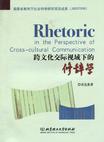跨文化交际视域下的修辞学
出版时间:2010-7 出版社:北京理工大学出版社 作者:吴克炎 页数:234
内容概要
英语修辞和汉语修辞是两个不同的概念,如何在两者之间寻求一个结合点就成了一个重要的研究课题。本书以跨文化交际为视角,以修辞效果为契合点,从修辞定义到论证过程都贯穿将两者有机结合这一思想。全书在充分对比研究英汉修辞、提供修辞基本研究框架的基础上,十分注重修辞的应用研究。由于双语转换过程中的句式语词选择以及文化意象转换大多数都涉及修辞现象,深入分析修辞效果遗失与保持的根本原因,能够促进对英语写作、英汉互译的深层理解,并且做到知其然而且知其所以然,特别有助于指导如何处理翻译过程中“形式与内容”之间的矛盾。此外,本书倡导“快乐修辞”理念,其例证有别于传统修辞著作,大部分是源自于生活的实例,与现实生活更加紧密结合;每个实例都有针对性的分析,更具阐释力,更具吸引力,更具生命力。全书用英语写作,适合具有一定英语基础的学习者学习,也适合作为修辞学教材使用。
作者简介
吴克炎,1970年生于福建省龙岩市。1994年毕业于漳州师范学院英语系并留校任教至今.现任漳州师范学院外语系副教授。2003年起担任外语系应用教研室主任。2004年获福建师范大学文学硕士学位。2009—2010年在北京大学担任教育部高等学校青年骨干教师国内访问学者。
主要从
书籍目录
序(辜正坤)ForewordChapter One Introduction Ⅰ.Definitions ofrhetoric A.Denotation Ofrhetoric B.Counotation ofrhetoric C.Six basic features of good expressions Ⅱ.Functions ofrhetoric A.Being more appropriate B.Being more attractive C.Being more forcible D.Being more humorous’ Ⅲ.Classification ofrhetoric Ⅳ.Rhetoric in the perspective of cross-cultural communicationChapter Two Comparison and Contrast Between English and Chinese Rhetoric Ⅰ.Language and rhetoric Ⅱ.Language.rhetoric and thought Ⅲ.English and Chinese rhetoric A.Passive rhetorical techniques B.Active rhetorical techniquesChapter Three 1nle Faculty of Rhetorical Invention Ⅰ.The origin ofrhetorical invention Ⅱ.The essence of rhetorical invention Ⅲ.The cases of rhetorical invention A.Controversial topic B.Non-controversial topicChapter Four Passive Rhetorical Techniques Section One Contextual Choice of Words and Expressions Ⅰ.Being fit for a certain situation Ⅱ.Being appropriate stylistically A.English examples B.Chinese examples Ⅲ.Being idiomatic A.Using idioms B.Using words in their figurative sense in English vs.words with vague reference or enigmatic folk similes in Chinese Section Two Textual Choice of Words, Expressions and Sentence Structures Part 1 English Prominent Feature: Elegant Variation Ⅰ.The solid basis A.Vocabulary B.Grammar Ⅱ.Various forms of variation A.Forms in diction B.Forms in sentence structures Part 2 Chinese Prominent Features Ⅰ.Sentence structure: elegance of balance Ⅱ.Elegance of artistic conception Section Three Application Part 1 Application of the English Prominent Features Ⅰ.Elegant variation A.Forms in diction B.Forms in sentence structures Ⅱ.English words in their figurative sense Part 2 Application of the Chinese Prominent Features Ⅰ.Chinese balanced structures Ⅱ.Periodic sentences Ⅲ.Chinese words with vague reference Ⅳ.Xiehouyu Part 3 Application of English/Chinese IdiomaticnessChapter Five Active Rhetorical Techniques Section One Devices Whose Rhetorical Effects Can Generally Be Retained A.Apostrophe B.Asyndeton,poly-syndeton C.Climax, anticlimax D.Contrast E.Epanorthosis F.Hyperbole, understatement G.Paradox, oxymoron H.Parallelism I.Personification, Niwu J.Rhetorical question Section Two Devices Whose Rhetorical Effects Can Partly Be Retained Ⅰ.On the psychological basis A.Allusion B.Metonymy, simile, metaphor C.Parody D.Symbol E.Synaesthesia F.Transferred epithet G.Zeugma, syllepsis Ⅱ.On the aesthetical basis H.Anadiplosis I.Antithesis J.Euphemism K.Irony, sarcasm,innuendo L.Malapropism M.Onomatopoeia N.Palindrome, antimetabole O.Pun Ⅲ.On the emphatic basis P.Anastrophe Q.Repetition Section Three Devices Whose Rhetorical Effects Cannot in General Be Retained Ⅰ.Figure of sound A.End rhyme B.Internal rhyme C.Assonance D.Alliteration E.Halfrhyme F.Consonance G.Paregmenon Ⅱ.Other figures of speech A.Caneci B.Chaizi C.Xianggian D.pianciBilingual Glossary of TermsBibliography后记
图书封面
评论、评分、阅读与下载
用户评论 (总计0条)
推荐图书
- 名师点拨·5年级语文(上)
- 名师点拨课课通·5年级英语上
- 5年级数学上
- 名师点拨 四年级英语上 配新课标人教PEP
- 名师点拨 四年级数学上配 新课标北师版
- 名师点拨课课通教材全解析(上)
- 名师点拨 三年级英语上 配新课标人教PEP
- 名师点拨 三年级数学上 配新课标北师版
- 名师点拨课课通(上)
- 11秋名师点拨七年级数学上
- 7年级数学上
- 6年级语文上 教材全解析 适合新课标语文s版
- 名师点拨课课通教材全解析(上)
- 名师点拨·6年级英语(上)
- 名师点拨 六年级数学上 配新课标北师版
- 名师点拨·9年级英语(上)
- 名师点拨课课通教材全解析(9年级上)
- 名师点拨课课通(上)
- 名师点拨 九年级数学上配 新课标北师版
- 名师点拨·2年级语文(上)
- 名师点拨 二年级数学上配 新课标北师版
- 名师点拨课课通·8年级英语上
- 11秋名师点拨八年级数学上
- 名师点拨 八年级数学上 配新课标人教版
- 名师点拨·8年级数学(上)
